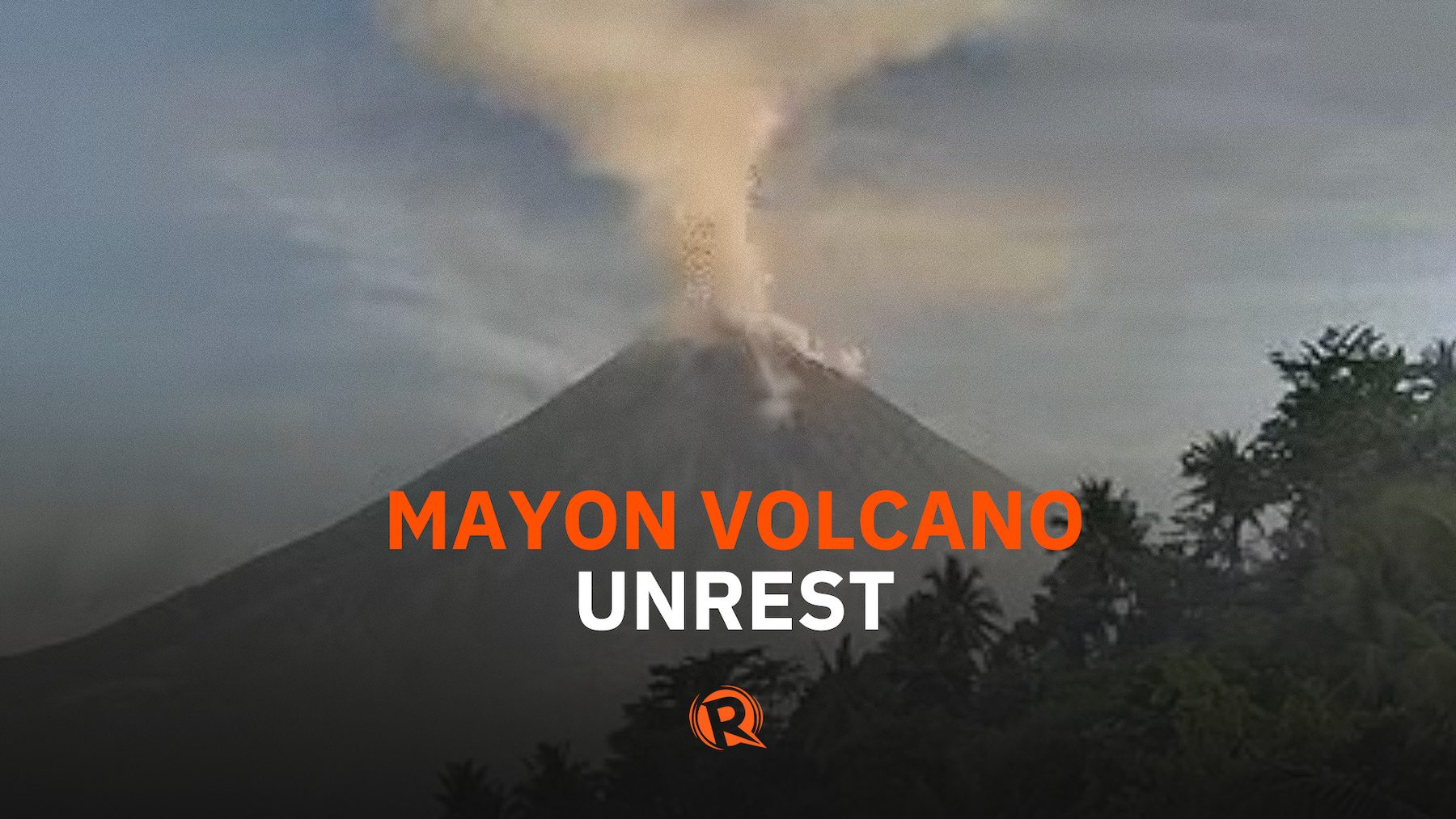WHAT YOU NEED TO KNOW
Albay province’s Mayon Volcano is showing an “increased tendency towards a hazardous eruption,” prompting the Philippine Institute of Volcanology and Seismology (Phivolcs) to raise Alert Level 3 on Thursday, June 8.
Chances are higher for “potential explosive activity within weeks or even days.”
Phivolcs warned of potential hazards such as pyroclastic density currents, lava flows, rockfalls, ashfall, and lahar. There is a 6-kilometer-radius permanent danger zone surrounding the volcano.
Bookmark this page for Phivolcs bulletins, information on government response, updates about evacuations, and other news about Mayon Volcano.
LATEST UPDATES
Phivolcs bulletin, June 16, 8 am
Phivolcs reported the following in its Mayon Volcano bulletin issued at 8 am on Friday, June 16, covering the past 24-hour period:
- very slow effusion of lava from the summit crater continued to feed lava flows and collapse debris on the Mi-isi (south) and Bonga (southeastern) gullies, with lava flows advancing around 1 kilometer from the summit crater and collapse debris deposited 2 kilometers from the crater
- 13 dome-collapse pyroclastic density currents lasting 2 to 6 minutes and extending 1 kilometer from the crater, with the largest PDC since June 8 occurring at 11:18 pm on Thursday, June 15, and depositing material within the upper 1 kilometer of the Mi-isi and Bonga gullies
- traces of ashfall dispersed from the PDCs reported in Sitio Buga, Barangay Nabonton, Ligao City, and in Purok 7, Barangay San Francisco, Guinobatan
- 307 rockfall events
- 4 volcanic earthquakes
- moderate emission of steam-laden plumes that rose 750 meters before drifting west and north northeast
- sulfur dioxide emission averaged 826 tons per day on Thursday
- inflated or swollen volcano edifice
Mayon Volcano has been under Alert Level 3 since June 8, which means it is “in a relatively high level of unrest,” according to Phivolcs. “Magma is at the crater and a hazardous eruption is possible within weeks or even days.”
WATCH: Pyroclastic density current on June 15
Phivolcs posts a time-lapse video showing a pyroclastic density current “being generated by lava dome collapse” from the #MayonVolcano summit at 11:18 pm on Thursday, June 15. This PDC lasted 6 minutes and is the largest recorded so far since the first generated on June 8. pic.twitter.com/0nLJAGODJD
— Rappler (@rapplerdotcom) June 16, 2023
Lava continues flowing for fifth night
This has generated “an increasing amount of rockfall and pyroclastic density current activity,” with 2,087 rockfall and 32 PDC events from June 1 to 12 am of June 16. https://t.co/Ji86HPZCjJ
— Rappler (@rapplerdotcom) June 16, 2023
Sorsogon donates P2.5 million to Albay
The Sorsogon provincial government donated P2.5 million to the Albay provincial government on Thursday, June 15, to help thousands of families who evacuated due to the Mayon Volcano unrest.
In a Facebook post on Thursday, Albay Governor Grex Lagman thanked Sorsogon Governor Boboy Hamor for the donation.

Phivolcs bulletin, June 15, 8 am
Phivolcs reported the following in its Mayon Volcano bulletin issued at 8 am on Thursday, June 15, covering the past 24-hour period:
- 2 volcanic earthquakes
- 306 rockfall events
- lava is flowing very slowly from the summit crater, with lava flows reaching the Mi-isi (south) and Bonga (southeastern gullies) within 1 kilometer from the crater
- 3 dome-collapse pyroclastic density currents lasting 3 to 6 minutes
- moderate emission of steam-laden plumes that rose 700 meters before drifting northwest
- fair crater glow or banaag and incandescent rockfall shed from new fluidal lava at the summit
- sulfur dioxide emission averaged 193 tons per day on Wednesday, June 14
- inflated or swollen volcano edifice
Mayon Volcano has been under Alert Level 3 since June 8, which means it is “in a relatively high level of unrest,” according to Phivolcs. “Magma is at the crater and a hazardous eruption is possible within weeks or even days.”
Marcos to gov’t agencies: Give 90 days of aid for evacuees
President Ferdinand Marcos Jr. ordered national government agencies to ease the burden of local government units in Albay by providing 90 days worth of relief assistance for evacuees affected by the Mayon Volcano unrest.
“Malay natin magkabagyo pa, may mangyari pa, para mayroon silang reserba pa. Hindi natin uubusin ‘yung kanilang quick response fund, number one,” Marcos said during a situation briefing at the Albay Astrodome in Legazpi City on Wednesday, June 14.
(They should have reserves left for storms and other calamities. Their quick response fund should not be depleted, number one.)
Science and Technology Secretary Renato Solidum Jr. earlier said in the same briefing that the unrest may last for up to three months.

Based on Office of Civil Defense data, 4,400 families or 15,676 persons have been displaced. Of the total, there are 4,215 families or 15,017 persons staying in 22 evacuation centers, while the rest are temporarily living elsewhere.
Social Welfare Secretary Rex Gatchalian said 153,000 food packs have been dispatched for the evacuees.
DepEd to set up temporary learning centers in evacuation centers
The Department of Education (DepEd) said on Wednesday, June 14, that it is planning to set up temporary learning centers in evacuation centers in Albay.
The department announced this plan during a situation briefing on the status of Mayon Volcano, held in Legazpi City and led by President Ferdinand Marcos Jr. The President had asked the DepEd for measures to allow children to continue their education amid the unrest.
Marcos visits evacuees in Guinobatan
President Ferdinand Marcos Jr. visited evacuees at Guinobatan Community College in Guinobatan, Albay, on Wednesday, June 14.
Marcos assured evacuees that the national government would respond to their needs, especially food, drinking water, medicines, and sanitation kits and equipment.
He also thanked the United Arab Emirates for donating 50 tons of relief goods.
All photos by Alfred Frias/Philippine News Agency



Over 16,000 residents evacuated amid Mayon unrest
The National Disaster Risk Reduction and Management Council (NDRRMC) on Wednesday, June 14, said 16,161 have been evacuated in Albay province due to the continuing unrest of Mayon Volcano.
In an 8 am bulletin on Wednesday, the NDRRMC also said Camalig, Malilipot, Daraga (Locsin), Tabaco City, Ligao City, and Guinobatan suspended classes in public schools from preschool to elementary.
Meanwhile, Albay has so far received an estimated P33.35 million in assistance.
Phivolcs bulletin, June 14, 8 am
Phivolcs reported the following in its Mayon Volcano bulletin issued at 8 am on Wednesday, June 14, covering the past 24-hour period:
- 7 volcanic earthquakes
- 309 rockfall events
- lava is flowing very slowly from the summit crater, with lava flows reaching the Mi-isi (south) and Bonga (southeastern gullies) within 1 kilometer from the crater
- 7 dome-collapse pyroclastic density currents lasting 4 minutes
- moderate emission of steam-laden plumes that “bent and crept downslope before drifting east”
- fair crater glow or banaag and incandescent rockfall shed from new fluidal lava at the summit
- sulfur dioxide emission averaged 149 tons per day on Tuesday, June 13
- inflated or swollen volcano edifice
Mayon Volcano has been under Alert Level 3 since Thursday, June 8, which means it is “in a relatively high level of unrest,” according to Phivolcs. “Magma is at the crater and a hazardous eruption is possible within weeks or even days.”
